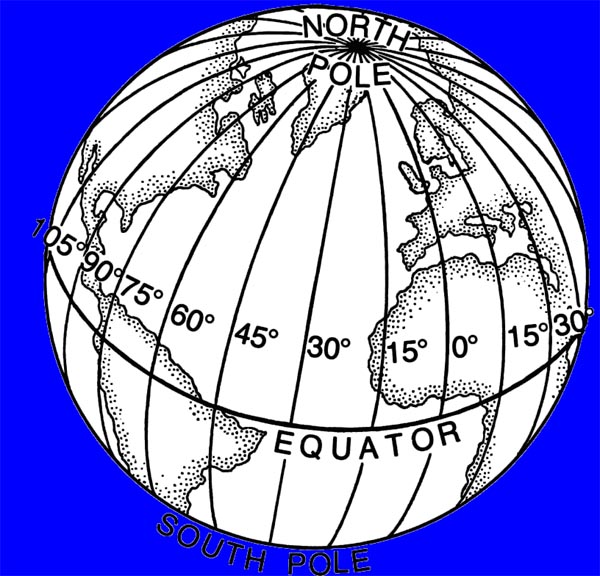 |
| Earth with meridians of longitude (Wikipedia) |
Note: Lily and Antonio complete the conversation they started in Lessons #03-002 and #03-003, about the earth's "grid" of lines.
Get Ready: Which hemisphere do you live in, north or south? East or west?
Lily, from China, and Antonio, from Spain, finish their conversation about geography in the Common Room of their dorm.
Lily: Hey, Antonio. Let's do longitude.
Antonio: <rubbing his hands together> Ready!
Lily: So, latitude is measured by the horizontal lines on the globe--
Antonio: Parallels.
Lily: Right. And the lines of longitude that run north to south are called "meridians."
Antonio: Hey, that sounds familiar.
Lily: Yeah, the word is used in a few expressions. For example, the "Prime Meridian" is the 0-degree line that runs through Greenwich, England.
Antonio: I remember now. Every thing to the east of that, to the 180 line, is the Eastern Hemisphere.
Lily: Yes, and to the west is the Western Hemisphere.
Antonio: If the Prime Meridian is in England, then isn't most of Europe in the "east"?
Lily: Technically, I guess you're right.
Antonio: OK. Anyway, I think I heard "meridian" somewhere else...
Lily: Well, you know "a.m." and "p.m." don't you?
Antonio: Naturally. Before and after noon on a 12-hour clock.
Lily: Yeah. Actually, "noon" is when the sun is over head, on (or near) the same meridian where you're located. The "a" in "a.m." means "ante," or before, and the "p" of "p.m." means "post"--
Antonio: After!
Lily: Exactly. So "a.m." and "p.m." are "ante meridiem" and "post meridiem," before and after noon.
Antonio: "MeridiEM?"
Lily: Don't worry, it's a Latin thing.
Antonio: OK. Here's a toughie: Is 12 noon really 12 a.m. or 12 p.m.?
Lily: Actually, it's neither. If a.m. is BEFORE noon, and p.m. is AFTER, then noon itself can't be before OR after.
Antonio: But still...
Lily: But nuthin'. Just stick with "12 noon" and you'll be OK.
Antonio: And "12 midnight" for the other one?
Lily: That's best.
NOTES:
- The "12-hour clock" is used in many English-speaking parts of the world, where we say "1 p.m." rather than "13:00." The clock used in some other places is called a "24-hour clock."
- When Antonio says, "MeridiEM?" he wants to know why it isn't "meridian." When Lily says, "it's a Latin thing," she means that the change has to do with the rules of Latin grammar.
- Lily says "But nuthin'" because she doesn't think Antonio's objections are important; she stops him before he goes on. It's a little rude, but might be done between friends.
Read more: https://en.wikipedia.org/wiki/Longitude
Practice: Match the term to its definition below:
- do longitude
- rubbing his hands together
- the globe
- technically
- toughie
- stick with
- study or talk about [something]
- a difficult question
- continue to do something a certain way
- a gesture of excitement or enthusiasm
- the information may be true, but it's not really very important.
- the earth, or a 3-D model of it
Answers are in the first comment below.
Submitted to the Shenzhen Daily for January 12, 2012
This lesson received 169 visits on my old site between January, 2012, and July, 2021.


Answers to the Practice: 1. a; 2. d; 3. f; 4. e; 5. b; 6. c
ReplyDelete